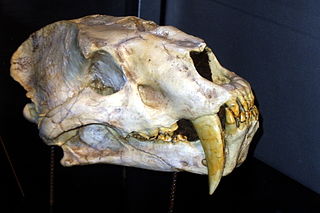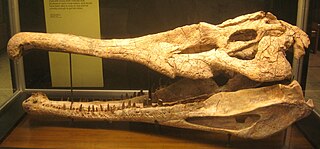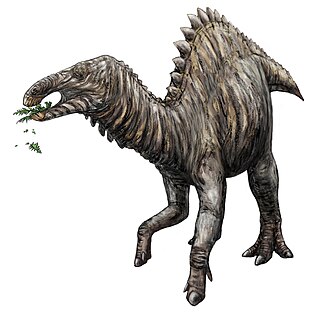 W
WAmphimachairodus is an extinct genus of large machairodonts belonging to the clade known as Eumachairodontia along with relatives like Smilodon and Homotherium. It is also a member of the tribe Homotherini within Machairodontidae and is most closely related to such species as Xenosmilus, Homotherium itself, and Nimravides. It inhabited Eurasia, Northern Africa and North America during the late Miocene epoch.
 W
WAnodontosaurus is an extinct genus of ankylosaurid dinosaurs within the subfamily Ankylosaurinae. It is known from the entire span of the Late Cretaceous Horseshoe Canyon Formation of southern Alberta, Canada. It contains two species, A. lambei and A. inceptus.
 W
WAntarctosaurus is a genus of titanosaurian sauropod dinosaur from the Late Cretaceous Period of what is now South America. The type species, Antarctosaurus wichmannianus, and a second species, Antarctosaurus giganteus, were described by prolific German paleontologist Friedrich von Huene in 1929. Three additional species of Antarctosaurus have been named since then but later studies have considered them dubious or unlikely to pertain to the genus.
 W
WBrachysuchus is an extinct genus of phytosaur known from the late Triassic period of Dockum Group in Texas, United States. It is known from the holotype UMMP 10336 is composed of a skull, lower jaws and partial postcranium and from the associated paratype UMMP 14366, nearly complete skull, recovered from the 'Pre-Tecovas Horizon' in the Dockum Group. It was first named by Case in 1929 and the type species is Brachysuchus megalodon. Its closest relative was Angistorhinus. However, its rostral crest was much smaller than that of Angistorhinus, and the rostrum as a whole is shorter and thicker.
 W
WCrassigyrinus is an extinct genus of carnivorous stem tetrapod from the Early Carboniferous Limestone Coal Group of Scotland and possibly Greer, West Virginia. The type specimen was originally described as Macromerium scoticum and lacked a complete skull. With subsequent discoveries, Crassigyrinus is now known from three skulls, one of which is in articulation with a fairly complete skeleton, and two incomplete lower jaws. Crassigyrinus grew up to 2 meters in length, coupled with tiny limbs and unusually large jaws. Crassigyrinus is taxonomically enigmatic, having confused paleontologists for decades with its apparent fish-like and tetrapod features. It was traditionally placed within the group Labyrinthodontia along with many other early tetrapods. Some paleontologists have even considered it as the most basal Crown group tetrapod, while others hesitate to even place it within the Tetrapoda superclass. Crassigyrinus had unusually large jaws, enabling it to eat other animals it could catch and swallow. It had two rows of sharp teeth in its jaws, the second row having a pair of fangs. Crassigyrinus had large eyes, suggesting that it was either nocturnal, or lived in very murky water.
 W
WEopelobates is an extinct genus of frogs in the family Pelobatidae. Closely related to the living European spadefoot toad, it is known from the Eocene of western North America, and the Eocene–Pliocene of Europe. It is suggested that the distribution over both Europe and North America is due to dispersal during the Paleocene-Eocene Thermal Maximum.
 W
WEuhelopus is a genus of sauropod dinosaur that lived between 129 and 113 million years ago during the Early Cretaceous in what is now Shandong Province in China. It was a large quadrupedal herbivore. Unlike most other sauropods, Euhelopus had longer forelegs than hind legs. This discovery was paleontologically significant because it represented the first dinosaur scientifically investigated from China: seen in 1913, rediscovered in 1922, and excavated in 1923. Unlike most sauropod specimens, it has a relatively complete skull.
 W
WHipposaurus is an extinct genus of basal therapsids known from the Tapinocephalus Assemblage Zone of the Main Karoo Basin, South Africa. Chronologically this is within the Capitanian stage of the Guadalupian Series. The genus was first described by S.H. Haughton as H. boonstrai on the basis of a skull and associated skeleton and was later considered a gorgonopsian in the family 'Ictidorhinidae' by Robert Broom. It is now considered a basal biarmosuchian, but its affinities remain uncertain. H.boonstrai is currently known from only two specimens in the Iziko South African Museum, Cape Town.
 W
WLaplatasaurus is a genus of titanosaurian sauropod dinosaur that lived during the Late Cretaceous in South America.
 W
WNephrops is a genus of lobsters comprising a single extant species, Nephrops norvegicus, and several fossil species. It was erected by William Elford Leach in 1814, to accommodate N. norvegicus alone, which had previously been placed in genera such as Cancer, Astacus or Homarus. Nephrops means "kidney eye" and refers to the shape of the animal's compound eye.
 W
WNotiomastodon is an extinct proboscidean genus of gomphotheres endemic to South America from the Pleistocene to the Holocene. It was among the last known gomphotheres and one of two South American gomphotheres alongside Cuvieronius, and was the predominant gomphothere on the continent ranging widely over most of South America excluding the high Andes. The species has a long and convoluted taxonomic history due to its morphological variability and confusion with related gomphothere taxa, which was only resolved during the 2010s.
 W
WParanthodon is a genus of stegosaurian dinosaur that lived in what is now South Africa during the Early Cretaceous, between 139 and 131 million years ago. Discovered in 1845, it was one of the first stegosaurians found. Its only remains, a partial skull, isolated teeth, and fragments of vertebrae, were found in the Kirkwood Formation. British paleontologist Richard Owen initially identified the fragments as those of the pareiasaur Anthodon. After remaining untouched for years in the British Museum of Natural History, the partial skull was identified by South African paleontologist Robert Broom as belonging to a different genus; he named the specimen Palaeoscincus africanus. Several years later, Hungarian paleontologist Franz Nopcsa, unaware of Broom's new name, similarly concluded that it represented a new taxon, and named it Paranthodon owenii. Since Nopcsa's species name was assigned after Broom's, and Broom did not assign a new genus, both names are now synonyms of the current binomial, Paranthodon africanus. The genus name combines the Ancient Greek para (near) with the genus name Anthodon, to represent the initial referral of the remains.
 W
WRangea is a frond-like Ediacaran fossil with six-fold radial symmetry. It is the type genus of the rangeomorphs.
 W
WSansanosmilus is an extinct genus of carnivorous mammal of the family Barbourofelidae endemic to Europe and Asia, which lived during the Miocene, 13.6—11.1 mya, existing for approximately 2.5 million years .
 W
WStyracocephalus platyrhynchus is an extinct species of tapinocephalian therapsids that lived during the Guadalupian epoch.
 W
WTanius is a genus of hadrosauroid dinosaur. It lived in the Late Cretaceous of China. The type species, named and described in 1929 by Carl Wiman, is Tanius sinensis. The generic name honours the Chinese paleontologist Tan Xichou. The specific epithet refers to China. In 2010 Gregory S. Paul estimated the length of Tanius at seven metres and the weight at two tonnes.
 W
WWeinbergina is a genus of synziphosurine, a paraphyletic group of fossil chelicerate arthropods. Fossils of the single and type species, W. opitzi, have been discovered in deposits of the Devonian period in the Hunsrück Slate, Germany.
 W
WXenastrapotherium is an extinct genus of astrapothere, a type of hoofed herbivorous mammal, native to South America, which lived in the Middle to Late Miocene period, typically during the Laventan stage. It is a member of the family Astrapotheriidae in the subfamily Uruguaytheriinae, large astrapotheres, equipped with a trunk-like nose and protruding teeth, similar to the elephants, but their tusks were the canine teeth, not the incisors. Xenastrapotherium was a genus widely distributed in northern South America, in contrast to other species of astrapotheres which lived in the area of the Southern Cone of the continent. It differed from other astrapotheres by having two lower incisors on each side of the jaw and the tusks have a pronounced longitudinal curvature, although their general shape and size are probably very similar to Astrapotherium, whose weight would be 900 to 1,500 kilograms, comparable to the current black rhino.